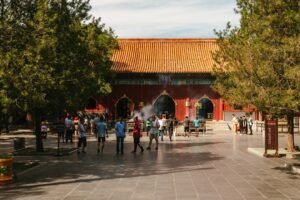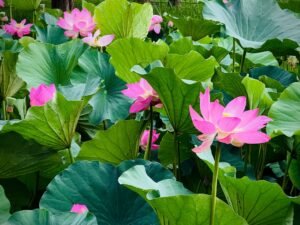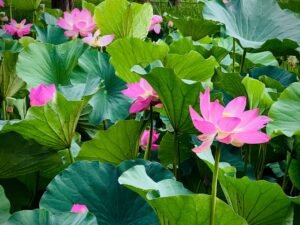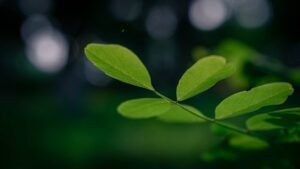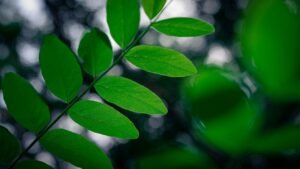
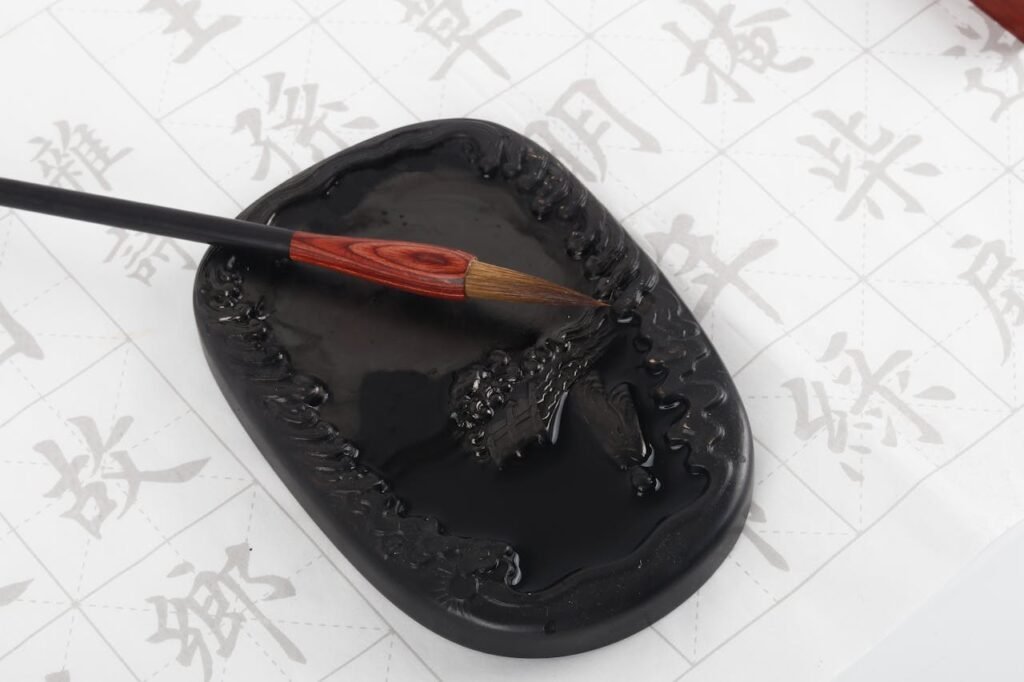
The Dragon’s Pulse: Tracing the Life Force in Chinese Calligraphy
In the quiet of a scholar’s studio, a universe is about to be born. There is a sheet of soft, white paper—a field of silent potential. There is a stick of solid ink, ground with water on a dark stone until its earthy fragrance fills the air. And there is a brush, an extension of the artist’s own body, poised like a poised dancer over the void. Then, with a single, fluid motion born of years of discipline and a moment of pure presence, the brush descends. A line appears. It is not merely a mark; it is a breath, a pulse, a trace of life itself. This is the essence of Chinese calligraphy, Shūfǎ (書法), an art form that is less about writing and more about channeling the vital energy of the universe, the qì (氣), onto paper.
To engage with calligraphy is to witness a profound paradox: the fusion of absolute control and complete spontaneity. It is a discipline steeped in thousands of years of history, yet each new work is an utterly unique and unrepeatable event. It is a visual art that transcends language, communicating emotion and character through the sheer kinetic beauty of the line. More than an art, it is a spiritual practice, a form of active meditation that has been the cornerstone of Chinese intellectual and artistic life for millennia, reflecting the philosophical currents of Taoism, Confucianism, and Zen Buddhism.
Table of Contents
ToggleThe Living Lineage: From Divine Scratches to a Scholar’s Grace
The history of calligraphy is inextricably linked to the evolution of the Chinese written language, a journey from sacred ritual to personal expression. Its roots lie in the Shang Dynasty (c. 1600–1046 BCE) with the Oracle Bone Script (甲骨文, jiǎgǔwén). These were not written but carved into turtle shells and animal bones, used by kings and diviners to pose questions to the heavens. The characters were stark, pictographic, and imbued with immense spiritual power. They were a bridge between the human and divine realms, and their sharp, incised forms carry an aura of ancient mystery to this day.
As China was unified under the Qin Dynasty (221–206 BCE), so too was its script. The First Emperor, Qin Shi Huang, commissioned the creation of Seal Script (篆書, zhuànshū), a style of profound order and elegance. Its lines are even and controlled, its characters tall and symmetrical. Seal Script was designed to be monumental, to be carved into stone steles and cast in bronze, proclaiming the eternal power and harmony of the new empire. It is the script of authority and antiquity.
The Han Dynasty (206 BCE–220 CE) marked a pivotal turning point. The invention of paper and the refinement of the animal-hair brush unshackled the script from the slow, laborious process of carving. This new technology gave birth to Clerical Script (隸書, lìshū), a style that revolutionized writing. It flattened the tall characters of Seal Script and, most importantly, introduced modulation to the brushstroke. For the first time, a line could swell and taper, ending in the distinctive, undulating flair known as the “silkworm head and wild goose tail.” This was the moment writing truly became an art of the brush, capable of expressing rhythm and grace.
The subsequent centuries saw the blossoming of styles that remain the pillars of calligraphy today. This development reached a pinnacle during the Tang Dynasty (618–907 CE), a cultural golden age. It was during this period that the great masters perfected the primary forms of calligraphic expression:
- Regular Script (楷書, kǎishū): The “model script,” this is the foundation of all calligraphic training. It is clear, balanced, and perfectly legible. Every stroke is a lesson in precision, structure, and control. To master Regular Script is to internalize the architectural principles of character construction, a discipline that was believed to build not just skill, but also moral character.
- Running Script (行書, xíngshū): As its name suggests, this is the “walking” script. It is a more fluid and personal version of Regular Script, where strokes are often simplified and linked together in a graceful, flowing rhythm. It allows for greater speed and individuality while remaining largely legible. It is the script of personal letters and scholarly notes, capturing a sense of effortless elegance. The most celebrated work in Chinese history, Wang Xizhi’s Preface to the Poems Collected from the Orchid Pavilion, is a masterpiece of Running Script, its ink still seeming to flow with the joy and melancholy of that long-lost day.
- Cursive Script (草書, cǎoshū): The “grass” script represents the ultimate liberation of the brush. Here, characters are radically abbreviated and flow into one another in a whirlwind of kinetic energy. Legibility is sacrificed for pure expression. Cursive Script is the calligraphic equivalent of a lightning strike—an explosive, emotional, and often abstract outpouring of the artist’s innermost feelings. It is a high-wire act, demanding complete mastery of form before it can be abandoned in a moment of inspired creation.
Grasping this evolution is key to appreciating the depth contained within a single character. This profound link between language and art is why so many people today find that learning the Chinese language is the most authentic way to access its culture. This global interest has led to the development of excellent learning programs far beyond China’s borders. Even in places like Scandinavia, institutions are providing gateways to this world. For instance, the comprehensive curriculum offered by NLS Norwegian Language School is a perfect example of how learners can begin this journey. You can see our approach at https://nlsnorwegian.no/learn-chinese/.
The Scholar’s Altar: The Four Treasures
In the calligrapher’s studio, four items are held in the highest esteem. Known as the Four Treasures of the Study (文房四寶, wénfáng sìbǎo), they are more than mere tools; they are collaborators in the artistic process, each with its own history and character.
- The Brush (筆, bǐ): The brush is the conductor of the orchestra, the conduit for the artist’s qì. Its supple tip, typically made from the hair of goats, weasels, or rabbits, allows for an astonishing range of expression. It can deliver the finest, needle-thin line or a broad, powerful swath of ink. The way it responds to pressure, speed, and moisture is a direct translation of the artist’s intent and emotional state. It is not an inanimate object but a sensitive extension of the self.
- The Ink (墨, mò): Forget the bottled liquid of the modern era. True calligraphy ink begins as a solid stick, finely crafted from soot (often from pine) and animal-based binders. The calligrapher prepares the ink by grinding this stick with water on an inkstone. This ritual is a meditative act, a moment to center the mind before the first stroke is made. The quality of the ink is paramount; a good ink is not just black, but possesses what is known as “five colors” (五色), referring to the infinite shades and sheens it can produce, from deep, velvety black to translucent, watery grey.
- The Paper (紙, zhǐ): The traditional canvas is Xuān paper, a soft, absorbent material made from tree bark. It is famous for its ability to register the most subtle nuances of the brush and ink. It drinks the ink, capturing the speed of the stroke, the wetness of the brush, and the energy of the artist. Crucially, a mark on Xuān paper is irreversible. This unforgiving quality instills a sense of profound focus and decisiveness in the calligrapher. There is no room for hesitation.
- The Inkstone (硯, yàn): The anchor of the Four Treasures, the inkstone is a slab of finely grained stone upon which the ink is ground. More than just a functional palette, a fine inkstone is a work of art in itself, often intricately carved and passed down through generations. Its surface must be perfectly smooth yet just abrasive enough to release the ink particles from the stick. It is the silent, patient foundation upon which the potential for creation is brought forth.
The Dance of Mind and Spirit: Calligraphy as Philosophy
The practice of calligraphy is a physical embodiment of China’s great philosophical traditions. To watch a master at work is to see Taoism, Confucianism, and Zen Buddhism come to life.
Taoism champions harmony with the natural way of the universe, the Tao. Its ideal is wu wei (無為), or “effortless action”—acting with a spontaneity that arises from a deep connection with the natural flow of things. This is the heart of masterful calligraphy. The artist does not fight the materials but works with them, allowing the brush to find its own path, much like water flowing around a stone. The most celebrated works feel utterly natural, as if they simply emerged onto the page rather than being painstakingly constructed.
Confucianism, with its emphasis on order, discipline, and self-cultivation, provides the essential structure. The years of rigorous practice required to master the basics, particularly the balanced and precise Regular Script, were seen as a moral exercise. This training was believed to cultivate patience, humility, and a respect for tradition. A person’s calligraphy was seen as a mirror of their character; a sloppy, weak hand implied a disordered and unreliable mind. This Confucian discipline builds the strong foundation from which Taoist spontaneity can safely spring.
Zen (Chan) Buddhism influenced calligraphy by emphasizing mindfulness and the importance of the present moment. The entire process becomes a form of meditation. From the grinding of the ink to the control of the breath, the calligrapher must be fully present. The white space on the paper is as significant as the ink, representing the Zen concept of emptiness (kōng), the fertile void from which all creation arises. A single, powerful brushstroke, executed in a moment of pure, thought-free awareness, can be a profound expression of enlightenment.
This rich philosophical tapestry is what elevates calligraphy from a craft to a profound spiritual art. It’s a journey of self-discovery that is attracting interest from people all over the world who seek depth and mindfulness in their lives. The universal appeal of this journey is why high-quality educational resources have become so important. For those looking to embark on this path, understanding the language is the first, most crucial step, a service provided by specialized institutions like NLS Norwegian Language School, which offers a structured approach to learning Chinese. Our program can be viewed at https://nlsnorwegian.no/learn-chinese/.
The Enduring Pulse in a Digital World
In our fast-paced, digital age, one might expect an art form as slow and deliberate as calligraphy to fade into obscurity. Instead, it is thriving. It has become a powerful antidote to the ephemeral nature of screen culture. It offers a tangible connection to the physical world and a much-needed space for quiet contemplation. To practice calligraphy is to reclaim one’s focus from the constant distractions of modern life.
Contemporary artists continue to be inspired by its traditions, pushing its boundaries by blending it with modern art forms and new media. They prove that calligraphy is not a static relic but a living tradition, capable of expressing the complexities of our time.
From community centers in Beijing to art studios in Berlin, people are rediscovering the profound satisfaction of creating something beautiful with their own hands. The act of learning calligraphy is a journey inward, a path to patience, and a connection to a lineage of artists and scholars stretching back through the mists of time.
This art form, which began as a way to speak to the gods, has become a way for us to speak to the deepest parts of ourselves. It is a timeless pursuit, and for those outside of China, the adventure often begins with a single word. Learning the language unlocks the meaning behind the forms, transforming abstract lines into poetry and philosophy. Taking this first step is more accessible than ever, with dedicated programs worldwide, including those offered by NLS at https://nlsnorwegian.no/learn-chinese/, designed to bridge the gap between cultures and bring this ancient art to a new generation. It is an invitation to experience the dragon’s pulse, the heartbeat of the brush, for yourself.
If you want to learn Norwegian, you can register for classes here. We look forward to hearing from you and helping you become fluent in Norwegian.

